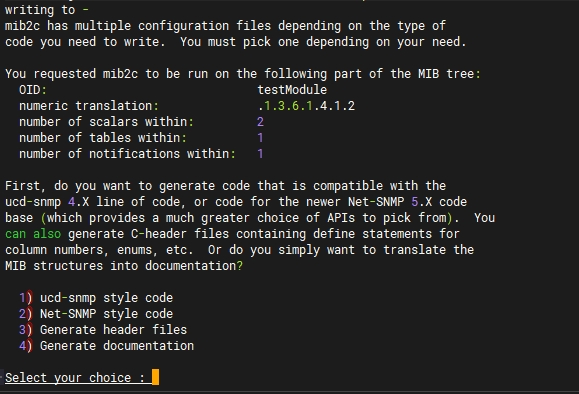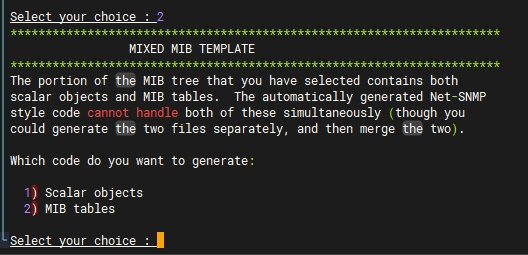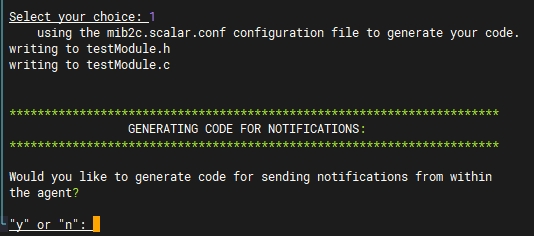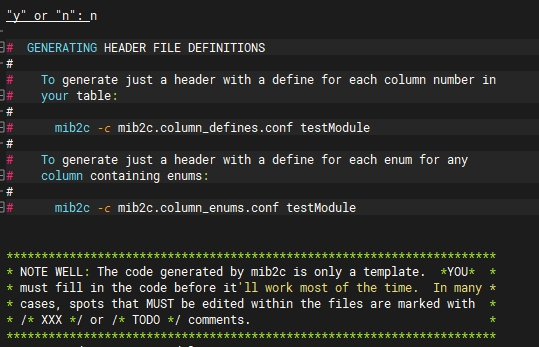mib2c --生成标量数据对应c文件
env MIBS="+/root/.snmp/mibs/TEST-MODULE.MIB" mib2c TEST-MODULE::testModule在ubuntu终端输入上面的指令前 确保 MIB文件已经拷贝到了对应的目录 另外确保mib2c工具已经安装了 前面Ubuntu安装snmp的两种方式 通过apt安装的时候会已经安装了mib2c工具
回车后提示:

这里询问我们选择那种类型的代码分格 我们后面 需要用net-snmp所以这里选择2

这里检查到我们的MIb树中包含标量和表格对象,这里自动生成的net-snmp分格的处理器不能同生成两种分格代码 需要分开生成 然后在合并 ,我们先生成标量类型的选择1

这里提示我们可以选择选择标量 API 风格还是魔法绑定整数变量
选择标量 API 风格(mib2c.scalar.conf)
自定义数据处理:需要手动实现标量值的获取/设置逻辑(如从硬件传感器读取数据或写入配置)。
复杂业务逻辑:标量值与其他系统组件(如数据库、外部 API)交互时需额外处理。
灵活性要求高:需完全控制标量对象的行为(如验证输入、触发事件)
代码框架:
static int handle_myScalar(netsnmp_mib_handler *handler, ...) {switch (reqinfo->mode) {case MODE_GET:// 自定义获取逻辑(如读取系统时间)snmp_set_var_typed_value(...);break;case MODE_SET:// 自定义设置逻辑(如写入配置文件)break;}return SNMP_ERR_NOERROR;}魔法绑定整数变量(mib2c.int_watch.conf)适用
简单监控需求:标量值直接映射到内存中的整数变量(如计数器、状态标志)。
无需复杂逻辑:只需自动同步变量值与 SNMP 标量,无需额外处理。
快速原型开发:快速测试或临时监控某个整数值。
生成代码:自动创建变量与标量的绑定,例如
static int myScalar_value = 0; // 内存中的变量netsnmp_register_scalar(..., &myScalar_value);这里我们选择1

询问是否需要为notifications生成代码 这里我们选择n 如果选择y的话会覆盖前面的标量代码

最终生成的.c文件 有中文注释修改的地方就是后面我们需要调整的地方
/** Note: this file originally auto-generated by mib2c* using mib2c.scalar.conf*/#include <net-snmp/net-snmp-config.h>
#include <net-snmp/net-snmp-includes.h>
#include <net-snmp/agent/net-snmp-agent-includes.h>
#include "testModule.h"/** Initializes the testModule module */
void
init_testModule(void)
{const oid objtype1_oid[] = { 1,3,6,1,4,1,2,1,1 };const oid objtype2_oid[] = { 1,3,6,1,4,1,2,1,2 };DEBUGMSGTL(("testModule", "Initializing\n"));netsnmp_register_scalar(netsnmp_create_handler_registration("objtype1", handle_objtype1,objtype1_oid, OID_LENGTH(objtype1_oid),HANDLER_CAN_RWRITE));netsnmp_register_scalar(netsnmp_create_handler_registration("objtype2", handle_objtype2,objtype2_oid, OID_LENGTH(objtype2_oid),HANDLER_CAN_RWRITE));
}int
handle_objtype1(netsnmp_mib_handler *handler,netsnmp_handler_registration *reginfo,netsnmp_agent_request_info *reqinfo,netsnmp_request_info *requests)
{int ret;/* We are never called for a GETNEXT if it's registered as a"instance", as it's "magically" handled for us. *//* a instance handler also only hands us one request at a time, sowe don't need to loop over a list of requests; we'll only get one. */switch(reqinfo->mode) {case MODE_GET:snmp_set_var_typed_value(requests->requestvb, ASN_INTEGER,/* XXX: a pointer to the scalar's data */,/* XXX: the length of the data in bytes */);// snmp_set_var_typed_value(requests->requestvb, ASN_OCTET_STR,// "test", //定义的变量名称buff// strlen("test") //buff的长度// );break;/** SET REQUEST** multiple states in the transaction. See:* http://www.net-snmp.org/tutorial-5/toolkit/mib_module/set-actions.jpg*/case MODE_SET_RESERVE1:/* or you could use netsnmp_check_vb_type_and_size instead */ret = netsnmp_check_vb_type(requests->requestvb, ASN_INTEGER);if ( ret != SNMP_ERR_NOERROR ) {netsnmp_set_request_error(reqinfo, requests, ret );}break;case MODE_SET_RESERVE2:/* XXX malloc "undo" storage buffer */if (/* XXX if malloc, or whatever, failed: */) {netsnmp_set_request_error(reqinfo, requests, SNMP_ERR_RESOURCEUNAVAILABLE);}break;case MODE_SET_FREE:/* XXX: free resources allocated in RESERVE1 and/orRESERVE2. Something failed somewhere, and the statesbelow won't be called. */break;case MODE_SET_ACTION:/* XXX: perform the value change here */if (/* XXX: error? */) {netsnmp_set_request_error(reqinfo, requests, /* some error */);}break;case MODE_SET_COMMIT:// static char buff[256]="";// /* XXX: delete temporary storage */// memcpy(buff,requests->requestvb->buf,requests->requestvb->val_len); // 赋值// buff[requests->requestvb->val_len] ='\0'; //字符串结束符if (/* XXX: error? */) {/* try _really_really_ hard to never get to this point */netsnmp_set_request_error(reqinfo, requests, SNMP_ERR_COMMITFAILED);}break;case MODE_SET_UNDO:/* XXX: UNDO and return to previous value for the object */if (/* XXX: error? */) {/* try _really_really_ hard to never get to this point */netsnmp_set_request_error(reqinfo, requests, SNMP_ERR_UNDOFAILED);}break;default:/* we should never get here, so this is a really bad error */snmp_log(LOG_ERR, "unknown mode (%d) in handle_objtype1\n", reqinfo->mode );return SNMP_ERR_GENERR;}return SNMP_ERR_NOERROR;
}
int
handle_objtype2(netsnmp_mib_handler *handler,netsnmp_handler_registration *reginfo,netsnmp_agent_request_info *reqinfo,netsnmp_request_info *requests)
{int ret;/* We are never called for a GETNEXT if it's registered as a"instance", as it's "magically" handled for us. *//* a instance handler also only hands us one request at a time, sowe don't need to loop over a list of requests; we'll only get one. */switch(reqinfo->mode) {case MODE_GET:snmp_set_var_typed_value(requests->requestvb, ASN_INTEGER,/* XXX: a pointer to the scalar's data */,/* XXX: the length of the data in bytes */);break;/** SET REQUEST** multiple states in the transaction. See:* http://www.net-snmp.org/tutorial-5/toolkit/mib_module/set-actions.jpg*/case MODE_SET_RESERVE1:/* or you could use netsnmp_check_vb_type_and_size instead */ret = netsnmp_check_vb_type(requests->requestvb, ASN_INTEGER);if ( ret != SNMP_ERR_NOERROR ) {netsnmp_set_request_error(reqinfo, requests, ret );}break;case MODE_SET_RESERVE2:/* XXX malloc "undo" storage buffer */if (/* XXX if malloc, or whatever, failed: */) {netsnmp_set_request_error(reqinfo, requests, SNMP_ERR_RESOURCEUNAVAILABLE);}break;case MODE_SET_FREE:/* XXX: free resources allocated in RESERVE1 and/orRESERVE2. Something failed somewhere, and the statesbelow won't be called. */break;case MODE_SET_ACTION:/* XXX: perform the value change here */if (/* XXX: error? */) {netsnmp_set_request_error(reqinfo, requests, /* some error */);}break;case MODE_SET_COMMIT:/* XXX: delete temporary storage */if (/* XXX: error? */) {/* try _really_really_ hard to never get to this point */netsnmp_set_request_error(reqinfo, requests, SNMP_ERR_COMMITFAILED);}break;case MODE_SET_UNDO:/* XXX: UNDO and return to previous value for the object */if (/* XXX: error? */) {/* try _really_really_ hard to never get to this point */netsnmp_set_request_error(reqinfo, requests, SNMP_ERR_UNDOFAILED);}break;default:/* we should never get here, so this is a really bad error */snmp_log(LOG_ERR, "unknown mode (%d) in handle_objtype2\n", reqinfo->mode );return SNMP_ERR_GENERR;}return SNMP_ERR_NOERROR;
}
